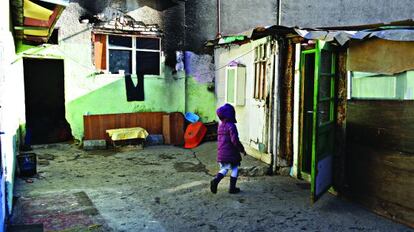Spain’s child poverty rates on the rise
Save the Children report calls on government to take “emergency measures” Almost a third of Spanish children are now at risk

Almost 27 million minors are at risk of poverty or exclusion from society in Europe, according to data from the EU’s Quality of Life Survey for 2012, which is used in a Save the Children report on child poverty that was published this week. The report shows that a million more children are now living in poverty compared to 2008, when the economic crisis began, although half the increase was registered between 2011 and 2012.
The growth in child poverty distances the EU still further from reaching the goals laid out in Europa 2020, which aims to help 20 million people out of poverty as defined by the AROPE indicator, which takes into account a household’s earnings, ability to provide food and clothing, and whether parents are employed.
In Spain, 29.9 percent of the population aged 18 or under lives below the poverty line, the highest after Romania
According to AROPE’s criteria, 20.8 percent of the population aged 18 or under in the EU lives below the poverty line. In Spain, the figure is 29.9 percent, the highest after Romania. Overall in the EU, nine percent of children live in homes where parents are not fully employed, and 11.8 percent lack proper food or clothes. In total, 28 percent of minors are at risk of poverty and social exclusion. Spain once again heads the ranking, with 33.8 percent of children affected by AROPE’s poverty criteria.
Save the Children warns that only half of EU member states are meeting their requirement under Europe 2020, which they signed up to in 2002, to address child poverty. “Equal access to education and a decent upbringing is essential to guarantee equal opportunities,” says the NGO. Some 13 percent of children in the EU leave school during their first year of secondary education and do not take up any kind of training. Spain leads the league table in this regard: 24.9 percent of children leave school early.
Save the Children says that the link between state spending on protecting children at risk of poverty is clear. It points to Austria, Slovenia and the Netherlands, where the state invests in child welfare, and compares them to Spain, Italy, Greece or Portugal, where “lower spending levels and a lack of strategies” translates into higher rates of children at risk.
“Lower spending levels and a lack of strategies” in Spain translate into higher rates of children at risk
Furthermore, says Save the Children, spending on social services and welfare is so low in some countries that there is no impact on child poverty. In Greece, state help for families has seen just a 2.9-percent drop for child poverty; in Spain, the figure is 6.9 percent. In contrast, Ireland has managed to reduce child poverty by 32 percent, while Germany has managed to help 15.6 percent of children who would otherwise be surviving on charity out of poverty. Andrés Conde, the director of the Spain division of Save the Children, says that the situation in Spain is “unacceptable,” and has called for the government to introduce “emergency measures.”
“Poverty in Europe has no passport,” says Save the Children’s report, noting that in wealthy countries like France or Italy between a third and a fifth of children are at risk of falling into poverty. Education and direct state aid are not the only areas that need addressing, it says. The organization says that 17 percent of European children live in poor quality accommodation. It also highlights the need to address a wider range of issues than food, clothing and housing, saying that it is important for children to have access to sports, cultural and leisure facilities.
Tu suscripción se está usando en otro dispositivo
¿Quieres añadir otro usuario a tu suscripción?
Si continúas leyendo en este dispositivo, no se podrá leer en el otro.
FlechaTu suscripción se está usando en otro dispositivo y solo puedes acceder a EL PAÍS desde un dispositivo a la vez.
Si quieres compartir tu cuenta, cambia tu suscripción a la modalidad Premium, así podrás añadir otro usuario. Cada uno accederá con su propia cuenta de email, lo que os permitirá personalizar vuestra experiencia en EL PAÍS.
¿Tienes una suscripción de empresa? Accede aquí para contratar más cuentas.
En el caso de no saber quién está usando tu cuenta, te recomendamos cambiar tu contraseña aquí.
Si decides continuar compartiendo tu cuenta, este mensaje se mostrará en tu dispositivo y en el de la otra persona que está usando tu cuenta de forma indefinida, afectando a tu experiencia de lectura. Puedes consultar aquí los términos y condiciones de la suscripción digital.
Últimas noticias
Most viewed
- Why we lost the habit of sleeping in two segments and how that changed our sense of time
- Trump’s obsession with putting his name on everything is unprecedented in the United States
- Pablo Escobar’s hippos: A serious environmental problem, 40 years on
- The Florida Keys tourist paradise is besieged by immigration agents: ‘We’ve never seen anything like this’
- Charles Dubouloz, mountaineering star, retires at 36 with a farewell tour inspired by Walter Bonatti









































